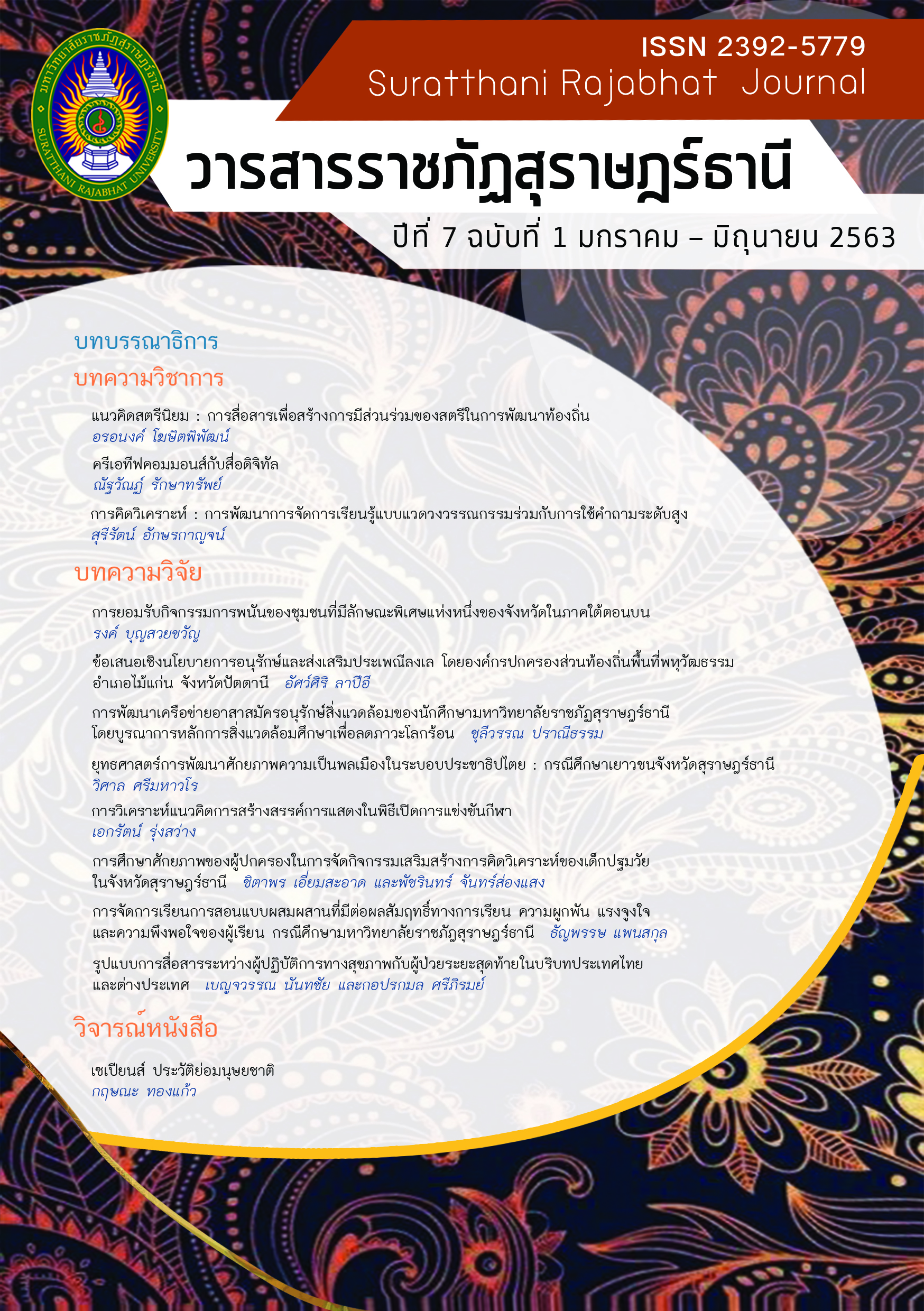Analytical Thinking : Development of Literature Circles and Higher Order Question
Main Article Content
Abstract
Analytical thinking is used to distinguish, discriminate and differentiate stories, events, or components of things in order to find the causal relationship and to search for the cause of things by considering, analyzing, and finding reasons of things carefully. According to Bloom’s taxonomy, there are 3 aspects; the analyzing of the essentialness, the relationship, and the principle. These skills can be developed by educating with the combinations of literature and high level of questions. It is the instructing process in which the learners set their goals of studying by questioning their teachers and friends. Those questions need the good analysis of the essentialness, the relationship, and the principle. This occurs through their searching for a variety of information, exchanging knowledge between learners and learners or learners and teachers in order to gain the answers to the questions. These may be revealed through speech, discussing, note-taking, text, or graphic organizers. This is the result of the essentialness, relationship, and principle of this concept. There are 5 steps of this instruction; 1) searching for background knowledge and grouping, 2) searching and questioning, 3) considering the answers, 4) reflecting and 5) presenting the analyzed data.
Article Details
References
ฆนัท ธาตุทอง. (2554). สอนคิด : การจัดการเรียนรู้เพื่อพัฒนาการคิด. นครปฐม : เพชรเกษมการพิมพ์.
ทิศนา แขมมณี. (2547). ศาสตร์การสอน องค์ความรู้เพื่อการจัดกระบวนการเรียนรู้ที่มีประสิทธิภาพ.กรุงเทพฯ : สำนักพิมพ์แห่งจุฬาลงกรณ์มหาวิทยาลัย.
วิชัย วงษ์ใหญ่. (2554). การพัฒนาหลักสูตรระดับอุดมศึกษา. กรุงเทพฯ : อาร์ แอนด์ ปริ้นท์.
วัชรา เล่าเรียนดี. (2556). รูปแบบและกลยุทธ์การจัดการเรียนรู้เพื่อพัฒนาทักษะการคิด. นครปฐม : โรงพิมพ์มหาวิทยาลัยศิลปากร.
ศุภชัย ถาดนาค (2556). การสร้างแผนการจัดการเรียนรู้โดยใช้เทคนิคการตั้งคำถามเรื่องระบบเศรษฐกิจโลกสำหรับนักเรียนชั้นมัธยมศึกษาปีที่ 5 โรงเรียนแม่ตื่นวิทยาคม จังหวัดเชียงใหม่. วิทยานิพนธ์ศึกษาศาสตรมหาบัณฑิต การสอนสังคมศึกษา คณะศึกษาศาสตร์ มหาวิทยาลัยเชียงใหม่.
ศรเนตร อารีโสภณพิเชารฐ. (2557). กลยุทธ์การเรียนการสอนเพื่อพัฒนาทักษะการคิดวิเคราะห์ : แผนที่มโนทัศน์ .วารสารครุศาสตร์, 42 (3), 194-210.
สุวิทย์ มูลคำและอรทัย มูลคำ. (2550). 21 วิธีการจัดการเรียนรู้เพื่อพัฒนากระบวนการคิด. (พิมพ์ครั้งที่ 6) กรุงเทพฯ : ภาพพิมพ์.
อินทรัตน์ ปัญญา. (2552). “การคิดเชิงวิเคราะห์” [ออนไลน์]. สืบค้นได้จาก http://cgsc. rta.mi.th/cgsc./index.php [11 พฤษภาคม 2559].
Bloom et al. (1976). Taxonomy of Education Objectives. Handbook I Cognitive Domain.New York : Divid Mclay Company


